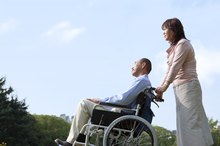What does fact checked mean?
At Healthfully, we strive to deliver objective content that is accurate and up-to-date. Our team periodically reviews articles in order to ensure content quality. The sources cited below consist of evidence from peer-reviewed journals, prominent medical organizations, academic associations, and government data.
The information contained on this site is for informational purposes only, and should not be used as a substitute for the advice of a professional health care provider. Please check with the appropriate physician regarding health questions and concerns. Although we strive to deliver accurate and up-to-date information, no guarantee to that effect is made.
Upper & Lower Eyelid Twitch and ALS Symptoms
Amyotrophic Lateral Sclerosis, also known as ALS or Lou Gehrig’s Disease, is a disease of the neurons that control voluntary muscle function. While uncommon, ALS is a progressive and fatal condition whose causes have not been identified. Early symptoms may be ambiguous and include involuntary twitches and tremors of muscles like the upper and lower eyelid, arm or leg. Learning about the nature of eyelid twitches and ALS allows you to recognize symptoms and seek diagnosis sooner 2.
Causes
Muscle twitches are a common and generally harmless occurrence. According to MedlinePlus, the most common causes of eyelid twitches are caffeine, stress and fatigue 1. More severe twitches are sometimes caused by corneal irritation, or irritation of the eye’s surface. Other times, the cause is unknown.
The cause of ALS has not yet been identified, though a combination of genetic and environmental factors are thought to play a role. No known preventive methods exist, and treatment is usually focused on alleviating symptoms and making the patient as comfortable as possible.
- Muscle twitches are a common and generally harmless occurrence.
- No known preventive methods exist, and treatment is usually focused on alleviating symptoms and making the patient as comfortable as possible.
ALS Symptoms
Restless Finger Syndrome
Learn More
Upper and lower eyelid twitches are just one possible symptom of ALS. Early symptoms are usually difficult to identify and may go unnoticed, becoming progressively worse until a diagnosis is sought. According to E Med TV, muscle twitching, stiffness and weakness are all possible symptoms of ALS 2. Other symptoms include difficulty chewing, walking and speaking. The body parts affected by early-stage ALS depend on the muscle groups damaged first. ALS does not affect a person’s ability to think or comprehend speech.
In some cases, upper and lower eyelid twitch may be accompanied by other symptoms such as eye irritation or difficulty seeing 1.
- Upper and lower eyelid twitches are just one possible symptom of ALS.
- In some cases, upper and lower eyelid twitch may be accompanied by other symptoms such as eye irritation or difficulty seeing 1.
Prevalence
Fortunately, ALS is a relatively rare condition. AmyotrophicLateralSclerosis.org states that roughly one in 100,000 people has the disease. It appears to be more common in Caucasian populations, though this may be due to differences in testing and other factors. It is not currently known what causes ALS or how to prevent it.
- Fortunately, ALS is a relatively rare condition.
- It is not currently known what causes ALS or how to prevent it.
Treatment
Mental and Physical Exhaustion
Learn More
While upper and lower eyelid twitch can signal ALS, these symptoms are more likely to be caused by other factors 12. MedlinePlus suggests reducing caffeine consumption and increasing the amount of sleep you get each night to help reduce eyelid twitches 1. In some cases, lubricating your eyes with eye drops may be helpful. For severe eyelid twitches that last longer than a week, see a doctor to prevent complications. Eyelid twitches that are accompanied by changes in muscle function elsewhere in the body may be signs of a more serious condition like ALS.
- While upper and lower eyelid twitch can signal ALS, these symptoms are more likely to be caused by other factors 1.
- Eyelid twitches that are accompanied by changes in muscle function elsewhere in the body may be signs of a more serious condition like ALS.
Related Articles
References
- MedlinePlus: Eyelid Twitch
- E Med TV: ALS Symptoms
- U.S. National Library of Medicine. MedlinePlus. Eyelid twitch. Reviewed August 28, 2018.
- American Academy of Ophthalmology. What Is an Eyelid Spasm or Twitching Eyelid? Reviewed September 10, 2019.
- American Academy of Ophthalmology. Eyelid Spasm and Twitching Treatment. Reviewed September 10, 2019.
Resources
Writer Bio
Based in Las Vegas, Tracii Hanes is a freelance writer specializing in health and psychology with over seven years of professional experience. She got her start as a news reporter and has since focused exclusively on freelance writing, contributing to websites like Wellsphere, Education Portal and more. She holds a Bachelor of Arts in communication arts from Southwestern Oklahoma State University.









